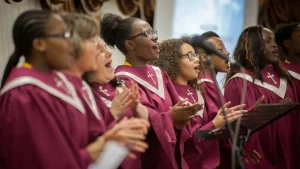The Bible is literally filled with references to singing and music, over 550 times in 44 of the 66 books of the Bible. The term “music” (and musician, “musical”, etc.) appears 75 times in the Bible, “song” 98 times, and “sing” (singing, singer, etc.) 196 times. Obviously, God loves praise and joyful singing. Many parts of the Bible contain spiritual songs! Organized music ministry was an important part of the Old Testament ministry system. Just like Gospel music has become an integral part of modern Christian culture. How did it appear, how is it different and what does it have in common with slavery? We understand.
Music of African tribes
The music of the African tribes of the 4th century ago differed from European and American white music in its fundamental aspect: there was no secular music in the African tradition. Europeans, in addition to religion, sang about love, war, about the historical events of the surrounding villages, about distant lands. Even if many of these songs mentioned God in one way or another, they are still talking about popular music (in our modern language) and secular music – rural or rural.

All African music, however, was sacred in nature, and the concept of secular music was foreign to it. It was supposed to serve the four main aspects of daily life: religion, the fertility of the earth and women, hunting and war. In this sense, African music had more common ground with American aboriginal music than with European music, given that singing was used as a means to interact with nature and the universe.
A practiced musical style that was introduced to America during the Ages of Slavery, between 1600 and 1865, is a call and response pattern in which the leader sings a stanza (analogous to our chant) and the others follow. Other stylistic features included the use of tambourines and drums for rhythmic, rather complex, accompaniment. An example of this style of call and response with syncopated rhythm was demonstrated by Ray Charles in “What’d I Say”.
In fact, it is very common to confuse or call by the same name different types of music (albeit of the same style), like spirituals (stress on the first syllable) and gospel. There is a significant difference between these two species, which, despite having common roots, have undergone such different admixtures and influences and performed in such different social and cultural contexts, which has given rise to musical products of distinctly different “taste”.
Spirituals can be defined as follows – these are religious chants composed by blacks, not written down and not published, but passed down from generation to generation with additions and variations, due to various circumstances.
What characterizes spirituals besides their religious character (or with a tendency to do so) is their oral and folk character, i.e. distinct from gospel music. The first references describing the performance of spirituals date back only to the 19th century and were written by people who managed to share the experience personally and participate in the performance along with the black diaspora.
Subsequently, many volumes with texts, melodic lines and annotations were published, among which the most complete and accurate, having collected materials from various collections, was released in 1867.
History of Gospel Music
The correct transcription of this word is gospel, not gospel, which can often be found in Russian-language texts. The word “gospel” literally translates from Old English as “good” or “good news”.
Gospel was born in the Methodist churches of South America. Willie Ruff, an Afro-English professor of music at Yale University, argues that gospel music has the same structure as the Scottish Presbyterian Church psalms.
This structure or shape, called lining out, was born from the fact that only one copy of the Bible at all was used in the church. The priest sang a line of the psalm to a group of parishioners, and they answered him, rehashing this line and enriching it with their timbre and emotions. Ruff claims, although many criticize him for academic racism, that this form of chant was heard by African-American slaves in their masters’ churches and developed into a new, personal style.
To keep the slaves in line, or perhaps out of fear, American slave owners did not allow blacks to use their traditional musical instruments, nor did they allow them to sing their folk music. Gradually, many texts and melodies were forgotten and disappeared in the spaces of North America.
It was as a result of this ancestral prohibition that a new kind of African-American music was born. New songs were written, using traditional African harmonies, call and response, rhythms, mixed, however, with traditional European harmonies and using musical instruments.
It must be understood that for 2.5 centuries the situation could not remain unchanged. All over the world progress was developing, freedom was gradually winning back one
foothold after another. The USA itself (so far only 13 northern states) became independent from the English crown in 1789, starting to spread the republican ideas of France on the American continent.
Interpenetration existed, and the white feudal planters nevertheless became different over time. Not all of them did not consider blacks to be people, and many allowed religion into their diaspora, allowing worship. And divine services there and then could only be Christian!
Black-produced gospel hymns used Christian themes, but with strong African vocal and rhythmic influences. The church became a sanctuary for expressing the feelings of black slaves. It was the only place where groups of slaves could gather without fear of oversight by white slave owners.
Naturally, among those slave owners who did not consider slaves to be animals, for sure, the “regime” for them was less cruel, and information about this was distributed among blacks and contributed to the growth of their desire for Christianity. Man is so arranged – he always needs hope. But, since still not all slave owners favored the religious education and prayers of slaves, meetings were often held in secret.
However, when and how exactly gospel was born is unknown, since the original sources have not been preserved.
Gospel recordings can be traced back to the last thirty years of the 19th century, when hymnbooks began to be produced for use in “black” churches. These hymns included religious songs of various kinds, with lyrics and melody.
The first such hymnal was published by Marshall W. Taylor, head of the Methodist Church, in 1882. Between 1880 and the early years of the 20th century, the foundations were laid for the further development of gospel music, thanks to the work of African-American composers, the most famous of which is Charles Albert Tindley (1859-1933) He is the author of famous hymns still played in churches, such as ” I’ll Overcome Someday”, “Stand by Me”, “We’ll Understand It Better By and By”, “The Storm is Passing Over”, “What are they Doing in Heaven?”.

Gospel music is usually divided into white and black. White gospel appeared before black, at the end of the nineteenth century. Then it was purely religious music, a combination of folk motives and traditional Christian hymns. Already at the beginning of the twentieth century, gospel became part of the music industry, entered the big stage. At the origins of the genre, one can recall the Carter Family group: their records were popular in the twenties and thirties of the last century.
Around the same time, the genre of black, black gospel appeared. He moved out of the Christian churches and into the masses thanks to Mahalia Jackson, the queen of black gospel. She was inducted into the Rock and Roll Hall of Fame as a singer who became a kind of “forerunner” of rock. Those years when Mahalia Jackson collaborated with Thomas Dorsey are considered to be the “Golden Age of Gospel”. It was at this time that the style became secular, went beyond religion.
Mahalia Jackson: “The blues is a pleasure to listen to – it’s a song of desperation. Gospel belongs to God – it’s a song of hope. Remember David from the Bible: “Sing loudly and joyfully to God.” I take his advice. The origin of gospel and blues is close, but blues only touches the heart, and gospel fills it with divine feelings of love, peace and joy.
Before World War II, large gospel choirs were popular. Such teams included up to 150 participants. After the war, the choirs turned into quartets, and men’s choirs were especially popular. Music has become commercial. The most popular “gospel quartet” of the time was the Soul Stirrers. They were the first to use only the guitar as an accompaniment. The influence of the Soul Stirrers affected the male rock and pop bands of the sixties, as well as the soul style.

James Cleveland has been called the “Louis Armstrong of gospel music”. In the fifties, working as a vocalist, producer and composer, he did much to popularize the gospel genre, and in 1968 he opened the Gospel Music Workshop. Gospel is also known for many other performers. The gospel style became the basis for the formation of such genres as jazz, rhythm and blues, soul and funk.
Among the choir-trained gospel singers are Sam Cooke and Clyde McPhatter, who helped bring the gospel into pop music. Soul’s triumphant rise in the 1960s was made possible only by gospel singers such as Aretha Franklin, Wilson Pickett, and Solomon Burke.
As part of the transformation of the Grammys in 2012, the National Academy of Recording Arts and Sciences introduced the Best Gospel Album award category. It combined the previous nominations for Best Contemporary R&B Gospel Album (1991-2011, until 2007 called Best Contemporary Soul Gospel Album), Best Rock or Rap Gospel Album (1991-2011) and Best Traditional Gospel Album (1991–2011; formerly known as Best Traditional Soul Gospel Album; 1978–1983 was Best Soul Gospel Musiccompletion, traditional”). It included the genres of urban gospel and soul gospel (Urban Gospel, Soul Gospel).
